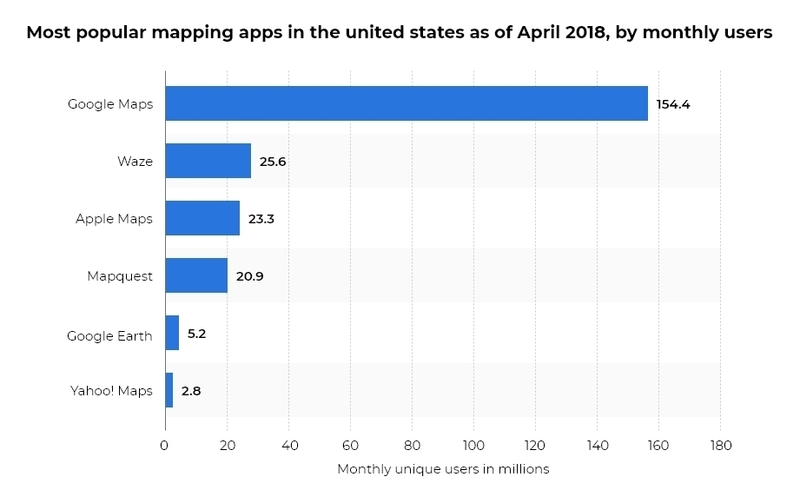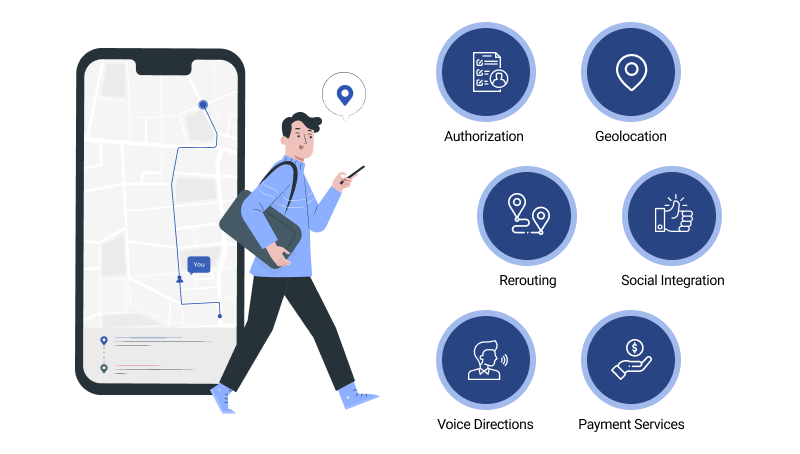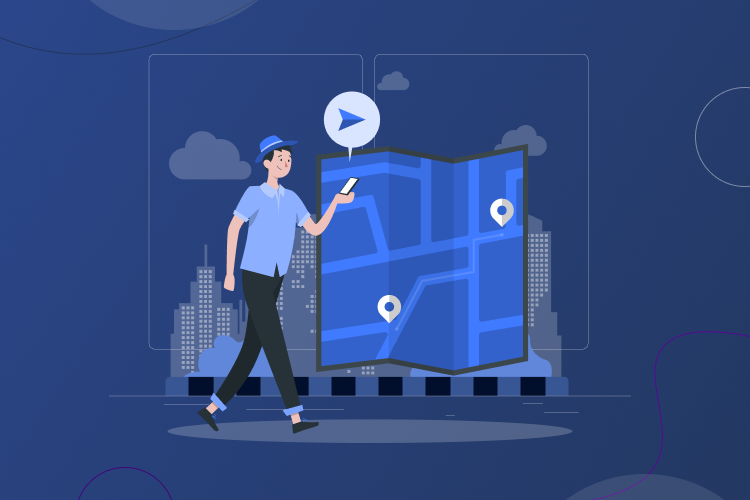How to Develop a GPS Navigation App like Waze?
- Mobile
- April 27, 2021
Navigation applications are getting highly popular these days. The number of location-based service users is predicted to increase in the future. Hence, if you are also planning for creating a GPS navigation app, you are on the right track.
According to the report by BIS Research Agency, the market of the navigation app is developing continuously, with an expectation of $34.56 billion income by 2021. Hence, having a navigation app can bring lots of profit to your business.
Waze and Google Maps are the two most famous apps for both Android and iOS in this sector. They provide turn-by-turn directions, lots of real-time data, and other features that make them more appealing.
The Concept of Waze App
Waze is a high-end GPS navigation app that has some amusing and useful features. This is the 2nd top-rated mobile app among users, beaten by Google Maps only. It allows users to get real-time traffic updates, use live maps, and other road information.

Waze was the 2nd most popular map app in the USA in April 2018. It had 130 million monthly active users in 2020. The yearly revenue of Waze is estimated at $37.7 million.
What is the reason behind Waze’s success? Take a look at how it works to know more!
How Does Waze Work?
Global users use Waze for enhancing one another’s routes by sharing real-time data regarding road repairs and traffic conditions. Waze helps you inform others regarding police traps, accidents, weather conditions, blocked roads, and so forth. This app instantly assesses this data to make sure that others can explore the ultimate routes. Waze is the official navigation app for many taxi booking apps like Lyft.
Waze is different from conventional GPS navigation app as it is community-driven, collecting traffic data and complementary map data from its users. Whenever the app is running, it collects data. It must have exact data from every closer road for offering the shortest route. At the time of your driving, the app will compare information for every possible route and provide the ultimate route as per your choice.
You require an active internet connection for loading routes as Waze does not work offline. To keep the map updated and power real-time traffic data, you need an internet connection.
In-app location-based advertising is Waze’s own ad product. It’s a location-guided ad platform for businesses that need to attract nearby drivers’ attention. While driving, you can see ads for nearby eateries, stores, and other areas.
The most interesting fact is that Waze assesses not just your area but also your destination to provide the most appropriate advertisements. This map app has made a system where any local business can claim locations on its maps while conveying local ads and targeted messages to people who are driving nearby and seeking a location.
What are the Key Features of a GPS Navigation App like Waze?

Before developing a Waze-like GPS navigation app, take a look at the major features to implement:
1. Authorization
It’s an important part of an app like Waze. After registration, users get personal accounts where they can put reviews and notes and communicate with others. You can either log in through your email and password or by connecting a social account like Facebook.
2. Real-Time Updates
Having high-quality satellite pictures in a navigation app is good enough, but Waze does something more. Real-time updates from other users make a highly fruitful user experience. Furthermore, you can upload images and add notes to offer other completely precise data.
3. In-App Messages
In case you want to pep up your Waze-like navigation app, think about displaying user messages more attractively. Do you want to deliver them as push notifications or send them to a chat? This can be done for navigation apps when a user enters a particular region or location.
4. Voice Navigation
Drivers should not be distracted by a map. Turn-by-turn navigation is a necessitous feature and a mobile GPS navigation app is nothing without it. Voice navigation helps drivers hear directions like where to turn or which route to use, traffic alerts, and notifications in case they have a better route. In case voice navigation distracts you, you can switch it off.
5. Social Networks Integration
You must integrate your app with social platforms for the reason of authentication and offering social features.
Moreover, social network integration improves user experience and reduces security risks around authentication because most possible problems and vulnerabilities are already maintained. Also, you will not be forcing users for making another account, but utilize their current accounts for seamless login.
6. Rerouting
Your GPS navigation app requires rerouting drivers fast in case they stumble upon a road accident or make a wrong turn that stops them from following the basic directions.
Drivers don’t need to wait for long for your app to reanalyze the route; they get precise directions directly.
7. Geolocation & Navigation
The map creates the basics of a navigation app. It utilizes the GPS system for deciding user location, locating objects, and showing the route.
To reduce mistakes, you can incorporate the Cell ID functionality in your app, as it depends on information coming from mobile operators. In case your team combines Cell ID and GPS, the Geolocation services of the app will be accurate.
8. Payment Services
A GPS navigation app might incorporate in-app purchases as a monetization method. In case your app becomes popular among drivers and people who offer complementary services, there is a possibility of partnership.
9. Carpool Service
A Waze-like Carpool app enables drivers to get free gas. In case any user is going in the same direction, you can see him on your screen. Drivers and riders share the gas expense for the trip. Ride charges are fixed beforehand at a rate recommended by the Waze-like app. The app charges the credit cards of bank accounts of users automatically.
10. Google Calendar Synchronization
The users of the Waze-like app can sync the app with Google Calendar for more feasible trips. When Waze gets access to the calendar, it makes a list of forthcoming appointments with their areas. This is how your navigation app can navigate travelers to their earlier entered areas.
Steps to Follow to Build a GPS Navigation App like Waze Successfully
To build a map app like Waze, your development team should follow the steps discussed below:
1. Conduct a Research
Start this project with a thorough study to enhance its success by recognizing its possible risks and weaknesses. The team must make a checklist to make sure the quality of every stage of planning, building, testing, and distribution of the app.
2. Select Your Tech Partner
You must select an app development company to develop your application. In this phase, you study, assess, and choose an organization to team up with you for building your navigation app. Signing an NDA is a key part of this app development process.
3. Fulfill Your Target Audience’s Needs
These days, users want smart navigation. They want the app to not just notify about traffic jams but also about speed cameras, for instance. Modern intelligent apps must also instruct drivers to reach the parking area near their destinations that have ample spaces and display gas prices.
4. Add As Many Handy Features as Possible
Add as many useful features as possible to your Waze-like navigation app so it can deliver an excellent service to all users.
5. Add Gamification Features
Gamification features help encourage users to return to your app. Take the points system as an example. Users receive points for various activities in the app, such as sharing road data or for kilometers driven with the app. These points can be compared with other drivers’ points.
6. Keep Your App’s UI/UX Design as Simple as Possible
Your app buttons must be visible and large enough so drivers can discover them and click them with no issue. Concentrate on the basic app functionality – the UI must comprise just the components needed at the time of navigation.
7. Add Voice Directions
Voice directions make navigation more secure as users won’t get distracted by looking at the mobile screen. Ensure to play the voice directions at the right time. When you accomplish this, users can follow them with no distraction – for instance, looking at the mobile screen. The same goes for sending lots of notifications at the time of navigation – users just must not receive lots of them.
App developers can use Google Maps Directions API that allows users to select the voice from the list and implement it.
8. Attach a Video during App Publishing
While uploading a map app like Waze for review, don’t forget to add a video that displays how the app works. Without this video, Google or Apple might reject your app, saying that they don’t know why they should allow your app to play audio and run in the background.
How Much Does It Cost to Build an App Like Waze?
The cost of a GPS navigation app like Waze is based on several factors, such as the rates of the development agency, the number of features, and the complexity of the project.
In case you want to keep the development process budget-friendly, begin with something smaller and easier. For instance, you can create an MVP first. It will help you get a rough estimate.

Closing Thoughts
A GPS navigation app helps people find a simpler way to their destination, check the roads’ situation, and report accidents. Moreover, many companies look for the chance to involve with navigation app users through advertisements. However, if you want to build a navigation app like Waze, follow the recommendations given in this blog and make your app famous among users.
FAQs About GPS Navigation App Development
You need technologies like Geolocation, Maps and navigation, Voice recognition system, Social elements, etc. to build an app like Waze.
Local brand advertising is one of the main revenue sources for the Waze app. Another way it earns money is Waze Carpooling.
The cost to build an app like Waze depends on many factors like the numbers of features you need, design complexity, the tech stack, the location of the development company, etc.













